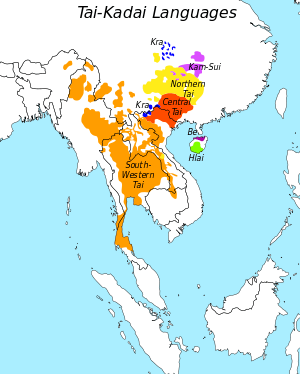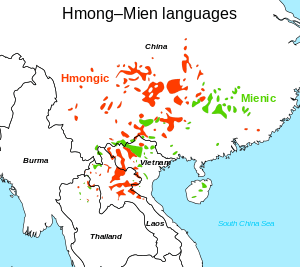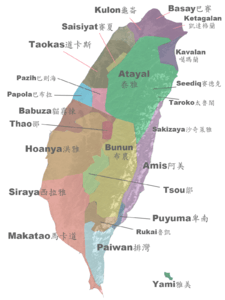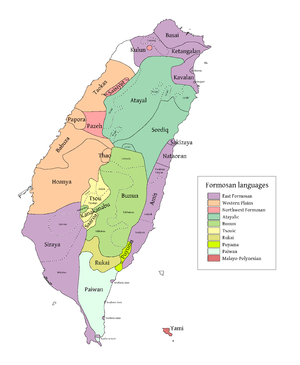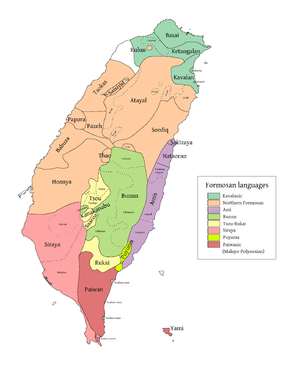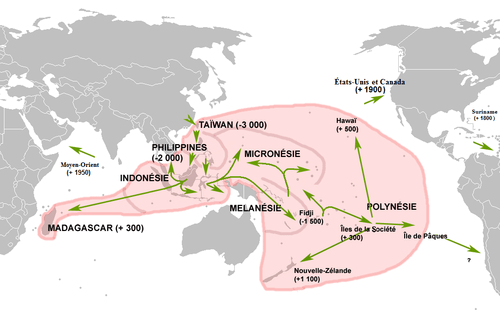Sino-Austronesian languages
Sino-Austronesian (now Sino-Tibetan-Austronesian) is a proposed language family. Its original version was presented by Laurent Sagart in 1990.[1] Using reconstructions of the Old Chinese language, Sagart argued that the Austronesian languages are related to the Sinitic languages phonologically, lexically and morphologically. Sagart later acknowledged that the Sino-Tibetan languages are a valid group and extended his proposal to include the rest of Sino-Tibetan.[2] Additionally, the Tai–Kadai languages were placed internally within the Austronesian family as a sister branch of Malayo-Polynesian ([3]). In the same paper, Sagart presented a phylogeny of the early phase of the Austronesian family.
Laurent Sagart has also shown that his Sino-Austronesian proposal does not contradict genetic studies in any major way.[4][5] If compared with genetic evidence, the Sino-Austronesian family would fall within Haplogroup O, a paternally-transmitted human Y-chromosome DNA haplogroup.
Related proposals include Austric (Wilhelm Schmidt), Austro-Tai (Paul K. Benedict), and Dené–Caucasian (Sergei Starostin).
Classification
- Sino-Austronesian (Sino-Tibetan–Austronesian)
Criticism
Ostapirat (2005)[6] supports the link between Austronesian and Kra–Dai (Sagart built upon Ostapirat's findings), but rejects a link to Sino-Tibetan. He notes that the apparent cognates are rarely found in all branches of Kra–Dai, and almost none are in core vocabulary.
Distributions
See also
References
- ↑ Sagart, L. (1990) Chinese and Austronesian are genetically related. Paper presented at the 23rd International Conference on Sino-Tibetan Languages and Linguistics, October 1990, Arlington, Texas.
- ↑ Sagart, L. (2005) Sino-Tibetan-Austronesian: an updated and improved argument. In L. Sagart, R. Blench and A. Sanchez-Mazas (eds) The peopling of East Asia: Putting together Archaeology, Linguistics and Genetics 161-176. London: RoutledgeCurzon.
- ↑ Sagart, L. (2004) The higher phylogeny of Austronesian and the position of Tai-Kadai. Oceanic Linguistics 43,2: 411-444.
- ↑ Sagart, Laurent. 2005. The formation of East Asian Language families: a partial scenario. Languages and genes: recent work and emerging results. Aussois: 22–25 September 2005. http://www.ohll.ish-lyon.cnrs.fr/pages/documents_Aussois_2005/pdf/Laurent_Sagart_et_al.ppt
- ↑ http://www.ddl.ish-lyon.cnrs.fr/colloques/NDHL2008/Powerpoint/10-Sagart.pdf
- ↑ Ostapirat, Weera. 2005. "Kra–Dai and Austronesian: Notes on phonological correspondences and vocabulary distribution." Laurent Sagart, Roger Blench & Alicia Sanchez-Mazas, eds. The Peopling of East Asia: Putting Together Archaeology, Linguistics and Genetics. London: Routledge Curzon, pp. 107–131.
- Sagart, Laurent 2005. "Sino-Tibetan–Austronesian: an updated and improved argument." In Laurent Sagart, Roger Blench & Alicia Sanchez-Mazas, eds. The Peopling of East Asia: Putting Together Archaeology, Linguistics and Genetics. London: Routledge Curzon, pp. 161–176.
- Sagart, Laurent. 2004. The higher phylogeny of Austronesian and the position of Tai–Kadai. Oceanic Linguistics 43:411–440.
- Sagart, Laurent. 1994. Proto-Austronesian and the Old Chinese evidence for Sino-Austronesian. Oceanic Linguistics 33:271–308.
- Sagart, Laurent. 1990. Chinese and Austronesian are genetically related. Paper presented at the 23rd International Conference on Sino-Tibetan Languages and Linguistics, October 1990, Arlington, Texas.
- Starosta, Stanley. 2005. "Proto-east Asian and the origin and dispersal of the languages of East and Southeast Asia and the Pacific." In Laurent Sagart, Roger Blench & Alicia Sanchez-Mazas, eds. The Peopling of East Asia: Putting Together Archaeology, Linguistics and Genetics. London: Routledge Curzon, pp. 182–197.
External links

